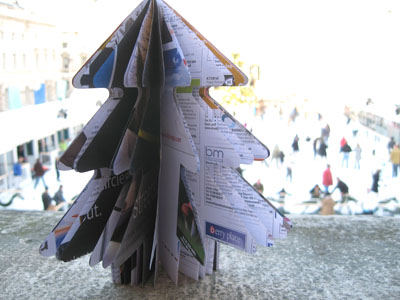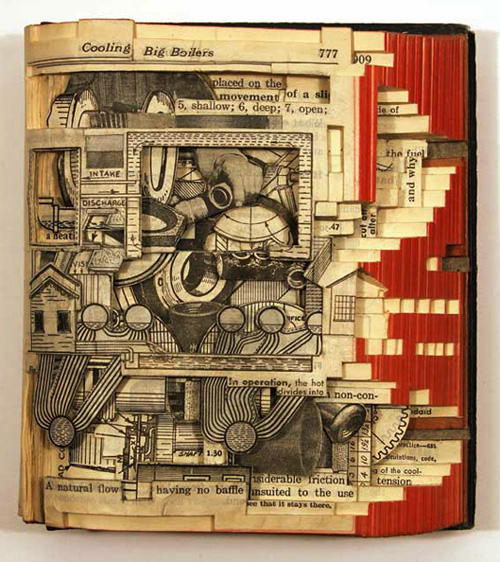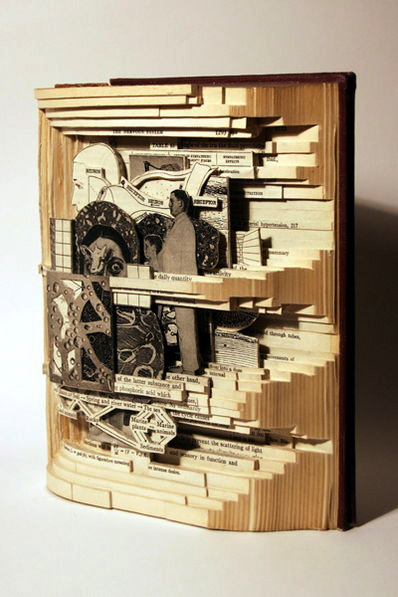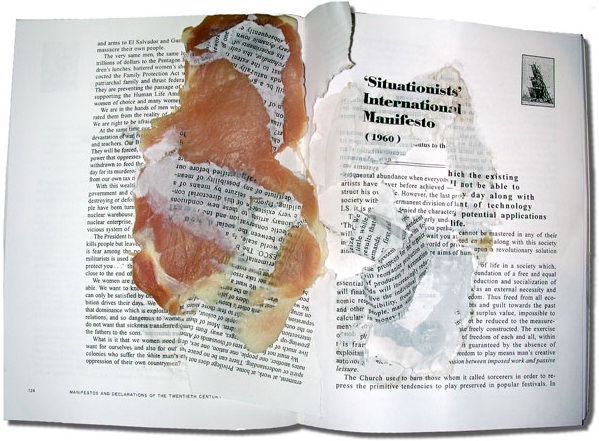| |
 |
 |
                   |
|
|
 |
 Recycle yourself : read
Recycle yourself : read |
 |
LEFT
(pragmatic) PAGE
Good morning. Every year
some 800.000 books are published, which means
every day there are approximately
1291 new books on the market.
Art books blogs:
links
Art
of the Book
How
to make art book
The
future of the book
Vegetal and
mineral memory: The
future of books- as seen by Umberto
Eco
WE
HAVE THREE TYPES OF MEMORY.
The first one is organic, which is the memory made of
flesh and blood and the one administrated by our brain.
The second is mineral, and in this sense mankind has
known two kinds of mineral memory: read full
article
The ancient Alexandria library
was not only a storehouse housing manuscripts gathered
throughout ancient times, from 400 BC to 300 AD, it
was the intellectual centre of Hellenistic culture.
The port of Alexandria was a favoured destination for
ships from all over the civilized world. The authorities
would visit the ships, borrow whatever documents or
manuscripts they carried, copy the data they contained
by hand and give the original texts back.
The library thus accumulated all available information
that could be accessed at the time and scholars flocked
to work on the manuscripts collected from all parts
of the then known world.
New
BIBLIOTHECA ALEXANDRINA 2003
visit library
online here
THE MOST INTERESTING
BOOKS OF THE DAY
?
VERSO
BOOKS:
ZIZEK!
One of my favorite philosophers (and a former compatriot)
Slavoj
Zizek published more than 50 books in last ten years.
FAMOUS
SENTENCE by
- Cervantes or Borges
? truth, whose mother is history,
rival of time, depository of deed, witness of the past,
exemplar and advisor to the present, and the future’s
counselor.
EXCREPT
Wagner
invented the term “civilized barbarism”.
D. Ouspensky: A New Model of the Universe:
Culture
strives to establish a boundary between itself and barbarism.
The manifestations of barbarism are called "crimes."
But existing criminology is insufficient to isolate
barbarism. It is insufficient because the idea of "crime"
in existing criminology is artificial, for what is called
crime is really an infringement of "existing laws,"
whereas "laws" are very often a manifestation
of barbarism and violence. Such are the prohibiting
laws of different kinds which abound in modern life.
The number of these laws is constantly growing in all
countries and, owing to this, what is called crime is
very often not a crime at all, for it contains no element
of violence or harm. On the other hand, unquestionable
crimes escape the field of vision of criminology, either
because they have not the recognized form of crime or
because they surpass a certain scale. In existing criminology
there are concepts: a criminal man, a criminal profession,
a criminal society, a criminal sect, a criminal caste
and a criminal tribe, but there is no concept of a criminal
state, or a criminal government or criminal legislation.
Consequently the biggest crimes actually escape being
called crimes.
|
|
 |
 |
RIGHT
(creative) PAGE
Children who read have
better test scores. And people who read are more likely
to have bigger incomes and more generous hearts, the
NEA says.
 Sustainable
book or just a great idea? Sustainable
book or just a great idea?
 Extraordinary
books
Extraordinary
books
Anatomy
of the book (by
Brian Dettmer)
 3
dimensional exploration of book content. 3
dimensional exploration of book content.
To
Be Or Not To Be?
In
order to become true, artist must prepare himself in
a way that cuts him off from the fellowship of the living.
(Merleau-Ponty)

Destroying
art manifestos of 20th Century (performance by
V.Sager)
This
summer, my reading curiosity was nourished by Michel
Fouault,
Giorgio Anamben, Edward Said, Vick
Muniz, Roger Shattuck, Carlos Castaneda, Milan Kundera,
etc..
If you dare, read the worst
paper in art history -
Art
After Philosophy (1969) by Joseph Kosuth here
Michel
Foucault: Selection of essential works 1954-1984.
Slavoj
Zizek: "The Ticklish Subject"
Frederick
Nietzsche: "Thus Spoke Zaratustra"
Bela
Hamvas: "Scientia Sacra" (I, II,
III)
P.D.
Ouspensky: "A New Model of the Universe"
Deleuze
& Guattari: "Capitalism and schizophrenia"
non-rated
Rene
Girard: "Scapegoat"
|
|
|
|
|
|
|
|

IN
THE MIDDLE OF THE CURRENT
( IDEAS )
please
visit www.documenta.de
and take a closer look
DOCUMENTA
12 KASSEL: Leitmotifs
documenta 12 has three leitmotifs. It is no accident that
they take the form of questions. After all, we create an exhibition
in order to find something out. Here and there, these motifs
may correspond, overlap, or disintegrate – like a musical
score.
Is modernity our antiquity?
This is the first question. It is fairly obvious that modernity,
or modernity's fate, exerts a profound influence on contemporary
artists. Part of that attraction may stem from the fact that
no one really knows if modernity is dead or alive. It seems
to be in ruins after the totalitarian catastrophes of the
20th century (the very same catastrophes to which it somehow
gave rise). It seems utterly compromised by the brutally partial
application of its universal demands (liberté, égalité,
fraternité) or by the simple fact that modernity and
coloniality went, and probably still go, hand in hand. Still,
people's imaginations are full of modernity's visions and
forms (and I mean not only Bauhaus but also arch-modernist
mind-sets transformed into contemporary catchwords like “identity”
or “culture”). In short, it seems that we are
both outside and inside modernity, both repelled by its deadly
violence and seduced by its most immodest aspiration or potential:
that there might, after all, be a common planetary horizon
for all the living and the dead.
What is bare life?
This second question underscores the sheer vulnerability and
complete exposure of being. Bare life deals with that part
of our existence from which no measure of security will ever
protect us. But, as in sexuality, absolute exposure is intricately
connected with infinite pleasure. There is an apocalyptic
and obviously political dimension to bare life (brought out
by torture and the concentration camp). There is, however,
also a lyrical or even ecstatic dimension to it – a
freedom for new and unexpected possibilities (in human relations
as well as in our relationship to nature or, more generally,
the world in which we live). Here and there, art dissolves
the radical separation between painful subjection and joyous
liberation. But what does that mean for its audiences?
The final question concerns education:
What is to be done?
Artists educate themselves by working through form
and subject matter; audiences educate themselves by experiencing
things aesthetically. How to mediate the particular content
or shape of those things without sacrificing their particularity
is one of the great challenges of an exhibition like the documenta.
But there is more to it than that. The global complex of cultural
translation that seems to be somehow embedded in art and its
mediation sets the stage for a potentially all-inclusive public
debate (Bildung, the German term for education, also means
“generation” or “constitution”, as
when one speaks of generating or constituting a public sphere).
Today, education seems to offer one viable alternative to
the devil (didacticism, academia) and the deep blue sea (commodity
fetishism).
Roger M. Buergel, December 2005
|
|
| |
|
|
|
|
| |
|
|
| |
On Late Style - study on "full
size" maturity in literature and music, by
Edward Said. Said died in 2003,
leaving this world without one virtuoso intellectual.
I highly recommend the "Parallels
and paradoxes", debates with Daniel
Barenboim. More than informative study
on "ripe" creativity.
Cantor
and Perversion by Roger Shattuck,
a collection of essays on arts & education.
Shattcuk is famous for his Forbidden Knowledge,
in which he raises the question: “Are there
some things we should not know?” Great variety
of topics. Quote from the book: "Younger
generations can hardly realize the intellectual
desert of England and America during the first
decade and more of this century. As time drains
into an expanded present, spiritual life shrinks
into momentary illuminations."
Companero:
The Life and Death of Che Guevara, by
J. Castaneda. How an ordinary person
became an extraordinary 20th century saint-revolutionary?
Best Che's biography so far.
Reflex
A Vik Muniz Primer
( Brazilian-US artist's confessions): Good source
for beginners. Here are some quotes I like:
- Ideology is utterly dependant on good hygiene.
- With the advent of Internet, the future has
invaded the present and the past, and we really
don’t have to remember anything, anymore.
- Plato: a true EIDOS is a genuine form or idea-m
for every object.Every attempt to represent eidos
with an image, results in EIDOLAS, or surface
image, without merit.
- Erudition is a rare syndrome; its basic symptoms
include ruined dinner conversations and ultimately,
chronic loneliness.
|
| |
|
|
|
| |
|
|
|
| |
|
|
|
| |
|
|
|
|
|
|
|